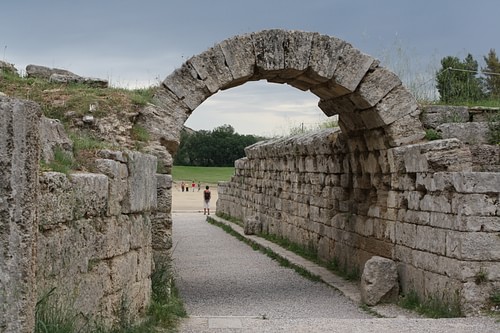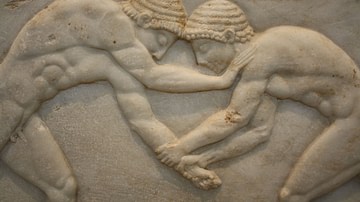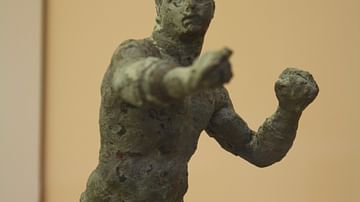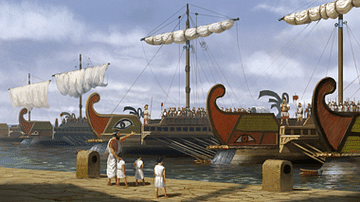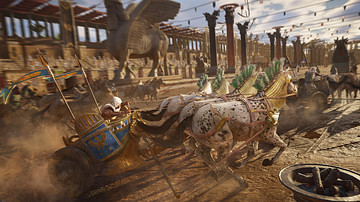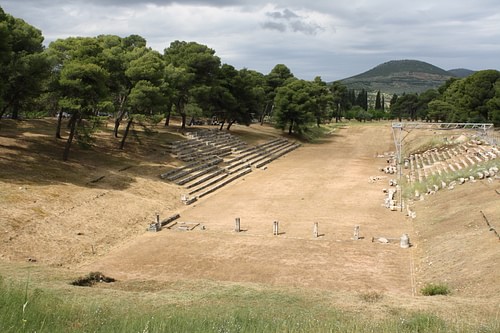
In the ancient Greek world, the word Stadium or stadion referred to a measurement of distance, a foot-race, and the place where the race was held and observed by spectators.
The Great Games
Greek sporting events were closely connected to religion, and for this reason Games were held at religiously important sites or sanctuaries. The competitions, held every two or four years and running over centuries, were to honour a particular deity or demi-god such as Zeus at Olympia (from 776 BCE), Apollo at Delphi (from 586 BCE), Poseidon at Isthmia (from 580 BCE), and Opheltes at Nemea (from 573 BCE). These constituted the four major Pan-Hellenic Games; however, other locations on the Greek mainland and islands also hosted regular athletic festivals. The oldest competition in these Games was the foot-race over a specified distance - the stade or stadion, which was 600 feet in length. As the foot (or pous) was not absolutely standardised throughout Greece, a stadion could vary in different locations from 177 m in length at Delphi to 192 m at Olympia. At Nemea small posts survive along the side of the track which mark every 100 feet along the stadion.
The stadion race was a single length of the track and equivalent to the modern-day 200 m running race. For the first 13 Olympic Games (776 BCE to 728 BCE) it was the only event, and even when other competitions were added to the Olympic programme, the stadion remained the first and most prestigious event. Victors in the stadion received a crown - of olive leaves at Olympia, pine (and then celery) at Isthmia, laurel at Delphi, and celery at Nemea - and received honours and gifts from their home city. However, the real prize was fame and glory. Victors won tremendous acclaim, giving their name to that Olympiad, for example, and quite literally, being hero-worshipped, sometimes even after their death. Perhaps the most celebrated athlete was Leonidas of Rhodes who won the stadion event in no less than four consecutive Olympiads.
From 724 BCE the athletic events were expanded to include other races such as the diaulos (two lengths of the track), hippios (four stadia), dolichos (a long distance race ranging from 7 to 20 stadia), and the race in armour or hoplitodromos (a two to four stadion race ran in greaves, helmet, and shield).
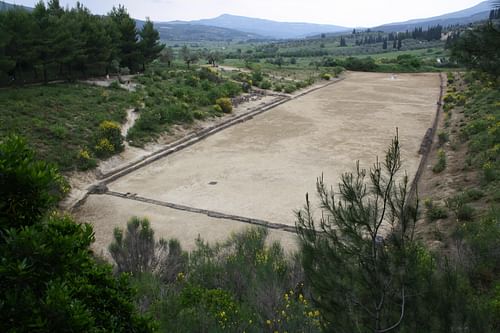
The Stadium Venue
The stadion was also the name of the place where spectators watched the event. The track itself was usually prepared with hard-packed clay (watered and rolled to create a hard crust) and included an area both before and after the stadion length. Behind the starting line, which was initially a simple line drawn in the track surface, was space for the starting judge, and after the finish line was a space for the athletes to slow down, usually 15 m in length (interestingly, this is also the regulation length for modern running tracks).
Over time, the starting procedure for races became more complex. In the 5th century BCE, permanent stone slabs (balbis) were placed across the track with parallel grooves for athletes (who competed naked and barefoot) to place their toes in, ensuring all started level and from a standing position. Another addition was small pillars on the starting line to demarcate the separate lanes which ranged from twentty-two at Nemea to 11 at Epidauros (if there were more runners than lanes, there were preliminary heats). Lanes were decided by lot (usually using pottery shards). Finally, in the 4th century BCE a complex system (hysplex) of pillars, horizontal poles, and rope created a mechanism whereby one starting judge could release all the athletes simultaneously. In the case of Isthmia, the judge stood in a pit behind the athletes. The finish was indicated by a simple line in the ground, and if the race was more than one stadion in length, a small turning post (kampter) was set up in the centre of the finish line.
Initially, stadia were simple, flat, rectangular tracks, sometimes built near natural hills for spectators to have a clear view of the events. However, from the early 5th century BCE artificial embankments became a common feature, as were conduits around the track to drain off excess rain water. The track also usually sloped a little (2 m at Nemea) for this purpose. Seats were later added either in stone as at Delphi, Delos, and Rhodes or in marble at Athens and Isthmia. The seating area also became more sophisticated with steps and divisions added to facilitate access and perhaps, more importantly, to ensure an orderly exit of the spectators. Certain VIP seats on a raised platform in the centre positions were a common feature. These were reserved for the specially trained judges (Hellanodikai) and at Olympia, for the priestess of Demeter Chamyne.
Seating capacity ranged from 30,000 at Nemea to as high as 45,000 at Olympia. In the case of the Pan-Hellenic Games, people came from all over Greece to enjoy the spectacle and intriguingly, numismatic evidence at Nemea strongly suggests that the crowds sat in geographical groups. Although young girls could enter, women were not permitted into the stadia during events. The crowd would participate in events both with vocal support and by throwing flowers or laurel leaves on the victor.
In the Hellenistic period a vaulted corridor (krypton) was added to stadia (e.g.: Olympia and Nemea) which became the entrance to the track for athletes and judges and connected the stadion to the rest of the religious complex. In Roman times, stadia entrances were made more monumental, and often semi-circular seating enclosed the starting end of the stadium.
